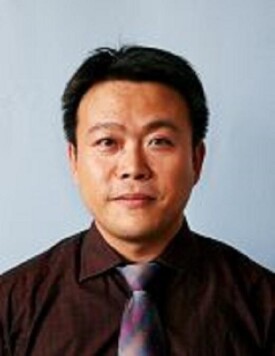張運海
安徽農業大學學院副院長、教授
張運海,男,1973年8月生,安徽省渦陽縣人,中共黨員,博士;現任安徽農業大學動物科技學院副院長、教授,兼任國際胚胎移植協會會員。
2007年3月完成丹麥博士后研究工作后回國任安徽農業大學教授,碩士生導師;安徽省“115”產業創新團隊帶頭人助理,安徽地方畜禽遺傳資源保護與生物育種省級實驗室副主任,安徽省第九批學術和技術帶頭人後備人選,2012年第十四屆安徽青年科技獎獲得者;兼任安徽省細胞生物學學會理事(2010年—至今)和安徽省野生動植物保護協會理事(2011年—至今);我國首例體細胞克隆豬主要創製人之一,作為骨幹成員參與獲得國際首例手工體細胞克隆豬。至今已經發表論文30餘篇,其中通訊或第一作者SCI收錄論文10餘篇;作為主要完成人獲授權國家發明專利3項、實用新型專利5項,在申請發明專利6項。主持或參與完成國家自然科學基金、“863”子課題、“973”子課題、國家“十一五”科技支撐計劃子任務等多項課題。現主持國家自然科學基金項目1項,參加國家轉基因生物育種重大專項、國家重大科學研究計劃各1項。獲國家科技進步獎二等獎(排名第八),神農中華農業科技獎一等獎(排名第五),安徽省科技進步獎三等獎1項。
1997—1999年:安徽省阜陽市黃牛改良中心,從事種公畜冷凍精液生產和獸醫工作;
1999—2002年:安徽農業大學,動物遺傳育種與繁殖專業,攻讀農學碩士學位;
2002—2005年:中國農業大學農業生物技術國家重點實驗室,生物化學與分子生物學專業,攻讀理學博士學位;
2005—2007年:丹麥奧胡斯大學(原丹麥皇家農業科學院)胚胎學專業,博士后;
2005—2007年:安徽農業大學講師;
2007—2012年:安徽農業大學副教授;
2008年—至今:安徽農業大學動物科技學院動物繁殖學課程組組長;
2008年—至今:安徽地方畜禽遺傳資源保護與生物育種省級實驗室副主任;
2010年—至今:安徽農業大學動物科技學院副院長;
2013年起:安徽農業大學教授。
Undergraduates: Animal Reproduction, Specialized English for Students Majoring in Animal Science
碩士生:動物胚胎工程和實驗,動物細胞工程和實驗
Postgraduate Candidates:Mammalian Embryonic Engineering and Experiments, Animal Cellular Engineering and Experiments
PhD Candidates: Animal Genetic Engineering, Advances in Animal Biotechnology
1. 動物胚胎工程產業化。以胚胎移植技術為核心,優化配子或胚胎玻璃化冷凍保存、胚胎體外生產、性別控制、超數排卵和同期發情等胚胎工程關鍵技術環節,並進行集成組裝熟化和示範推廣,著力為安徽省畜牧業良種體系再上新台階提供長效技術支撐。
3. 哺乳動物胚胎早期發育表觀遺傳修飾調控機制。體細胞克隆、誘導多功能幹細胞以及其他來源的體外胚胎為素材,開展哺乳動物胚胎著床之前發育機制,尤其是表觀遺傳修飾調節機制研究,為動物胚胎生產,建立長效的人類輔助生殖安全性、有效性評價模型,造福人類健康和生活。
2018-2010國家基金項目:豬體細胞克隆胚胎DNA甲基化和組蛋白乙醯化重編程的研究
Selected publications
Research papers (* Corresponding author)
(1) Chen Jian-wen, Zhang Yu, Zhang Yuan-liang, Wei Chao, Liu Xing, Zhou Na-ru, Jia Qing, Li Yun-sheng, Zhang Xiao-rong*, Zhang Yun-hai*,(2012) Construction of multiple shRNAs expression vector that inhibits FUT1 gene expression and production of the transgenic SCNT embryos in vitro. Molecular Biology Reports (published on line, December 1, 2012).
(2) Fang, F., Liu, Y., Zhao, X., Li, Y., Zhang, Y*., and Zhang, X*., (2012) The association between testicular ghrelin receptor mRNA and serum testosterone levels in immunocastrated boars. Animal Reproduction Science, 135: 62-7.
(3) Cao ZB, Sui LC, Li YS, Ji SF, Zhang XR, Zhang YH*, (2012) Effects of Chemically Defined Medium on Early Development of Porcine Embryos Derived from Parthenogenetic Activation and Cloning. Zygote, 20: 229-36.
(4) Yin HQ, Cao HG, Sun XP, Xue YJ, Zhang WQ, Huang WL, Tao Y, Liu Y, Li YS, Zhang YH*, Zhang XR*, (2010). Generation of Induced Pluripotent Stem Cells From Porcine Fibroblasts. Prog in Biochem and Biophy, 37: 607-612.
(5) Fang, F., Wang, L., Zhang, Y*., Li, Y., Su, S., & Zhang, X*.(2012) Role of Ghrelin on Estrogen and Progesterone Secretion in the Adult Rat Ovary During Estrous Cycle. Systems Biology in Reproductive Medicine, 58: 116-9.
(6) Wang, L., Fang, F., Li, Y., Zhang, Y*., Pu, Y., and Zhang, X*, (2011) Role of ghrelin on testosterone secretion and the mRNA expression of androgen receptors in adult rat testis. Systems Biology in Reproductive Medicine, 57(3), 119-123.
(7) Gui, T., Zhang, M., Chen, J., Zhang, Y., Zhou, N., Tao, J., Sui, L., Li, Y., Liu, Y., and Zhang, X., Zhang Y.*,(2012) In vitro evaluation of a mammary gland specific expression vector encoding recombinant human lysozyme for development of transgenic dairy goat embryos. Biotechnol Lett, 34: 1445-52.
(8) Zhang, Y., Li, Y., Zhang, Z., Cao, Z., Jiang, S., Yang, J., Zhang, X.., Fang, F.G., (2012)The Histological Structure and Location of Substance P in the Digestive Tract of the Siberian Tiger(Panthera tigris altaica). Journal of Animal and Veterinary Advances, 11: 735-741.
(9) Zhang, Y., Li, J., Villemoes, K., Pedersen, A.M., Purup, S., and Vajta, G., (2007). An epigenetic modifier results in improved in vitro blastocyst production after somatic cell nuclear transfer. Cloning Stem Cells, 9: 357-63.
(10) Zhang, Y.H., Pan, D.K., Sun, X.Z., Sun, G.J., Wang, X.B., Liu, X.H., Li, Y., Dai, Y.P., and Li, N., (2006) Production of porcine cloned transgenic embryos expressing green fluorescent protein by somatic cell nuclear transfer. Science in China Series C-Life Sciences, 49: 164-171.
(11) Zhang, Y.H., Pan, D.K., Sun, X.Z., Sun, G.J., Liu, X.H., Wang, X.B., Tian, X.H., Li, Y., Dai, Y.P., and Li, N., (2006) In vitro developmental competence of pig nuclear transferred embryos: effects of GFP transfection, refrigeration, cell cycle synchronization and shapes of donor cells. Zygote, 14: 239-247.
(12) Pan, D.K., Zhang, Y.H., Sun, X.Z., Zhang, J., Li, X.Y., Li, Y., Gu, Z.L., Dai, Y.P., Wu, C.X., and Li, N., (2006) Cloned pigs derived from somatic cell nuclear transfer embryos cultured in vitro at low oxygen tension. Chinese Science Bulletin, 51: 839-844. (equal contribution)
(13) Du, Y., Zhang, Y., Li, J., Kragh, P.M., Kuwayama, M., Ieda, S., Zhang, X., Schmidt, M., Bogh, I.B., Purup, S., Pedersen, A.M., Villemoes, K., Yang, H., Bolund, L., and Vajta, G., 2007. Simplified cryopreservation of porcine cloned blastocysts. Cryobiology, 54: 181-7.
(14) Vajta, G., Zhang, Y., and Machaty, Z., (2007). Somatic cell nuclear transfer in pigs: recent achievements and future possibilities. Reprod Fertil Dev, 19: 403-23.
(15) Li, F, Tao, Y, Zhang, Y, Li, Y, Fang, F, Liu, Y, Cao, H, Zhang, X, Zhou, S., (2010) Follicle growth and oocyte development after ovaries transplantation into back muscle of immune-intact adult castrated male mice. Reproduction, 140(3):465-476.
(16) Li, J., Villemoes, K., Zhang, Y., Du, Y., Kragh, P., Purup, S., Xue, Q., Pedersen, A., Jørgensen, A., Jakobsen, J., Bolund, L., Yang, H., Vajta, G., (2009) Efficiency of Two Enucleation Methods Connected to Handmade Cloning to Produce Transgenic Porcine Embryos. Reprod Domest Anim., 44(1):122-7.
(17) Li, J., Du, Y., Zhang, Y.H., Kragh, P.M., Purup, S., Bolund, L., Yang, H., Xue, Q.Z., and Vajta, G., 2006. Chemically assisted handmade enucleation of porcine oocytes. Cloning Stem Cells, 8: 241-50.
(18) Cao, H., Yang, P., Pu, Y., Sun, X., Yin, H., Zhang, Y., Zhang, Y., Li, Y., Liu, Y., Fang, F., Zhang, Z., Tao, Y., Zhang, X.*, (2012) Characterization of Bovine Induced Pluripotent Stem Cells by Lentiviral Transduction of Reprogramming Factor Fusion Proteins. International Journal of Biological Sciences, 8: 498-511
